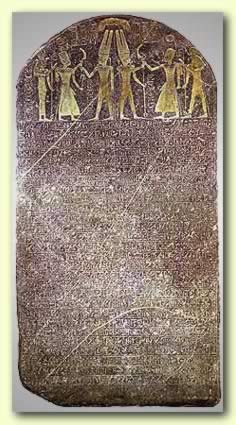from:
Israel Finkelstein / Neil A. Silberman:
The Bible unearthed. Archeology's New Vision of
Ancient Israel and the Origin of Its Sacred Texts; The
Free Press, a division of Simon & Schuster, Inc.,
2001; German edition has got the title "No trombones
before Jericho" (orig. German: "Keine Posaunen vor
Jericho"): edition C.H.Beck oHG, Munich 2002;
Here in this analysis is used the
German version "Keine Posaunen vor Jericho" of DTV,
Munich 2004, second edition of 2005. All page
indications refer to the German version. I hope the page
numbers are not very different.
1207
B.C.
There is a stele of victory
of Pharaoh Merenptah mentioning a great victory against
the Israelites
(p.28)

Victoria stele
describing victories of Pharaoh Merenptah |
Pharaoh
Merenptah is the son of Ramses II. According to
this "Merenptah stele" he is said having
defeated the Israelites in a successful campaign
at the end of 13th century B.C. The Israelites
are said having been expelled and massively
reduced claiming that Israel's "seed would be
off" (p.71).
This stele is the first safe historical proof of
a text mentioning the word "Israel" (p.71). But
the location of the alleged battle is not
mentioned. So, since 1207 B.C. it's only proved
that in Egypt it's known that some group exists
with the name of "Israel" (p.89).
According to archeology there are founded many
new villages in the highlands of Canaan at the
same time. These founding wave of new villages
can be connected with the expulsion of Israelite
population (p.71).
[It can be that the Israelites have played with
the sea peoples against Egypt, and Jerusalem was
at another place and is not detected yet?
Archeology cannot say anything yet. This stele
is a mystery. Speculations may go on...]
|
12th century B.C. / interim period from Bronze Age to Iron
Age / end of Late Bronze Age / 1150 B.C. appr.
Collapse of Egypt and Hittite
Empires - wave of villages - villages and towns in the
highlands - independences
The powers are collapsing (p.134). City states of Canaan
are weakened
-- by raids of the sea peoples
-- by rivalries
-- or by social upheavals
-- accompanied by a fast economic decline.
Weakening of the city states of Canaan permits the
independence for the city states in the highlands -
Shechem (Bible name for "Israel") and Jerusalem (Bible
name for "Judah") (p.178).
The
survivors of the regions win the independence. The
populations of the villages are probably producing just
for their personal needs. But the heaviest consequences
suffer the Bedouins: They cannot change corn in the
villages any more and have to cultivate corn themselves
now, and now they are settling down, and there are more
villages installed (p.134).
So, according to Finkelstein / Silberman
the genesis of villages is the result of the collapse of
Canaanite culture, and the importance of the Israelite
villages is rising. The native people were the Canaanites.
Other peoples as the foreigners, Bedouins who are called
Israelites later, were not from the coastal region (p.135)
Wave of villages also in the
Eastbank of Jordan river
Also in the Eastbank of Jordan river can be proved the
same wave of foundations of villages. But this local
population is not Israelite, but is forming the kingdoms
of Ammon and Moab and Edom later (p.135).
1180-1130 B.C. appr.
Towns without
population
Some decades the big towns are left without
population, for example Megiddo, Tel Dor, or Tel Rehov
(p.179).
1150-586
B.C. / European Iron Age
The
highlands of Canaan are developing a change into
territorial states
(p.32)
since 1130 B.C. appr.
New
population in the towns of Canaan
The
fields of ruins are populated by the native Canaanite
population again. There follows a regeneration of the
towns, for example Megiddo, Tel Dor, or Tel Rehov, but the
towns are not that big like before (p.179).
[Town on hill of ruins
("Tell"): by this are acropolis created
Every town constructed on a hill of
ruins is 1.5 to 2 meters higher. The repeated events of
destruction and reconstruction gives the result of towns
on hills, and at the end these towns are on an acropolis].


